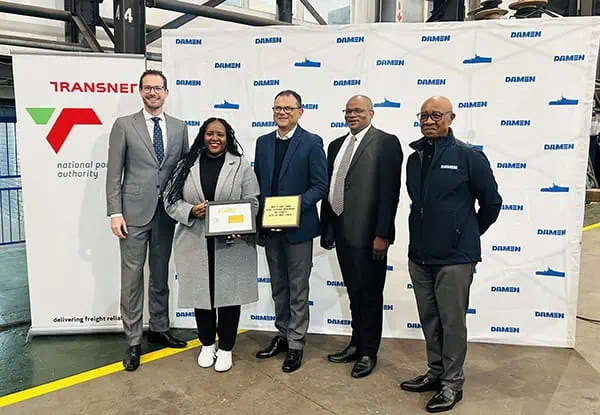In keeping up with the marine tradition of bequeathing fortune for vessel and crew, a keel laying ceremony was held on Friday, 10 May, in Cape Town to mark the beginning of construction of a new multi-purpose vessel that will increase marine fleet availability for Transnet National Ports Authority’s (TNPA’s) Port of Cape Town.
As the first milestone in the history of a ship, the keel laying ceremony marks the laying of the large beam around which the hull of a ship is built. In line with this tradition, the Mandela Peace Prize coin was placed underneath the keel – a tradition said to invite good fortune during construction and the life of the ship.
![]()
The vessel is being designed, manufactured, assembled, and commissioned by Damen Shipyards Cape Town (DSCT) and will be delivered to TNPA by February 2025. Damen scooped the contract through an open tender process. They have vast experience with low-cost maintenance vessels ensuring an optimal layout and maintainability of all installed high-quality components. The Western region is already starting to realise the economic benefits with the vessel being manufactured locally.
Speaking at the ceremony, TNPA Regional Manager for Operational Performance and Oversight at Western Region Ports, Captain Vernal Jones said, “The ongoing investment in reliable port infrastructure is the creation of new assets to enable economic activity in the region and will further ensure smooth operation at the port.”
The acquisition of this new vessel forms part of TNPA’s strategy to increase the efficiency of its marine fleet and it replaces the Pollution Control Vessel which has reached its operational lifespan. Over the past few years, the Pollution Control was confined to collecting debris, small-scale dredging in rivers, and performing maintenance work, and the new vessel has additional capabilities.
“DSCT is proud to be building the ship together with the local maritime industry. It creates and sustains jobs, allows us to continue training artisans on-the-job and collaboration with co- makers which actively contributes towards a future proof maritime industry,” said Jos Govaarts, Managing Director of DSCT.
Once operational, the new vessel will require additional human resources for manning. This includes two seafarers’ deck, one able seafarer engine, one skipper and one Marine Engineering Officer.
